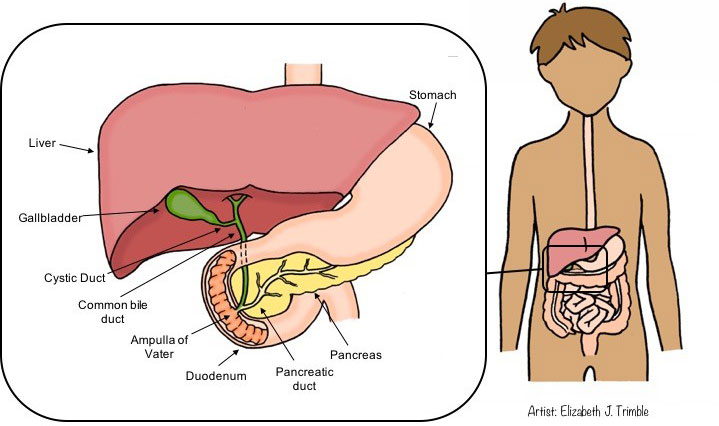By: Eveline Shue, MD, FAAP
Roughly one in five adults have gallbladder disease. Gallbladder problems such as gallstones are less likely in children and teens, but are becoming more common. Here's what parents need to know.
What is gallbladder disease?
The gallbladder is an organ located on the right side of the body, under the liver. The liver makes bile, a fluid that helps to digest food. The gallbladder stores the bile. When your child eats, the gallbladder releases bile through ducts that connect it to the intestine.

Gallbladder disease often happens when bile hardens and forms stones. It may be caused by or related to:
What problems can gallstones cause?
Children with gallstones may have:
Pain from stones in the gallbladder (biliary colic)
Infection of the gallbladder (cholecystitis)
Stones in the ducts draining the gallbladder that can block the flow of bile (choledocholithiasis)
Inflammation of the pancreas (pancreatitis)
What are some symptoms of gallstones in children?
Gallstones do not always cause symptoms. However, children with gallstones may have pain in the upper right or middle part of the belly, just below the rib cage. The pain may feel sharp, crampy or dull and spread to the back or right shoulder. It may come and go, getting worse after eating—especially foods high in fat.
If a gallstone blocks a duct, a child may also have:
Can children have gallbladder disease without gallstones?
Children sometimes have gallbladder problems that do not result in stones. These may include:
Acalculous cholecystitis. Children sometimes develop gallbladder inflammation without gallstones.
Biliary dyskinesia. With this condition, the gallbladder has trouble squeezing to release the bile. Usually, children with biliary dyskinesia have no stones in the gallbladder.
What tests will be done to diagnose gallbladder disease?
If doctors think your child is having gallbladder problems, they may ask for:
Blood tests
An ultrasound to look at the gallbladder
A magnetic resonance cholangiopancreatography (MRCP) to get detailed images of the bile ducts
A CT scan, usually if blood tests show inflammation or infection of the pancreas
A cholescintigraphy or hepatobiliary (HIDA) scan to look for infection or biliary dyskinesia
Note: diagnostic tests such as a cholescintigraphy or HIDA scan can have limited accuracy for non-gallstone gallbladder disease.
What can be done to make my child better?
Observation. Many parents and kids know what foods will cause gallbladder pain. These foods are often greasy foods or foods that have a lot of fat. Sometimes, pain can be made better by not eating these foods.
Medicine. There is currently no reliable medicine to make gallbladder disease go away.
Surgery. The only dependable way to fix gallbladder disease is to remove the gallbladder with surgery, a procedure called cholecystectomy. Gallbladder surgery, is usually done laparoscopically, using a video camera and a few tiny cuts or incisions. Your surgeon may recommend a procedure called a cholangiogram if the stones seem to be stuck in the ducts that drain bile into the intestine. This is done during surgery by putting dye into the bile ducts and taking x-rays.
Sometimes there is too much infection around the gallbladder and it is not safe to do the surgery laparoscopically. If this happens, your surgeon may need to do the surgery with one bigger incision.
Remember
Regular visits with your child's pediatrician can help avoid gallbladder problems by keeping health conditions that can make them more likely under control.
More Information
About Dr. Shue
 Eveline Shue, MD, FAAP, a member of the American Academy of Pediatrics Section on Surgery, is a pediatric general surgeon at Children's Hospital of Los Angeles and Long Beach Memorial Children's Hospital.
Eveline Shue, MD, FAAP, a member of the American Academy of Pediatrics Section on Surgery, is a pediatric general surgeon at Children's Hospital of Los Angeles and Long Beach Memorial Children's Hospital.